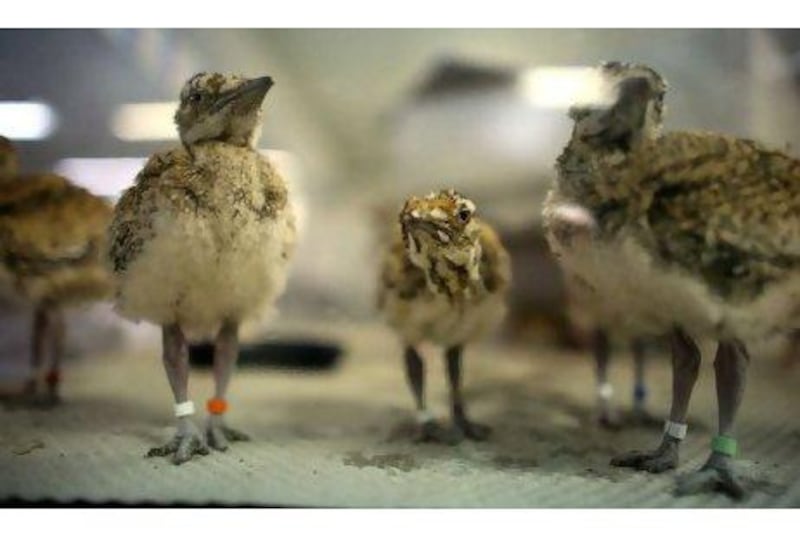ABU DHABI // After a major breakthrough reproducing houbara bustard chicks, scientists in the UAE are perfecting and expanding on their methods in hopes that one day soon they can repopulate the region with the endangered wild bird.
Teams working on two separate research projects in Abu Dhabi and Dubai, presented their findings yesterday to an audience of experts at the First International Symposium on Conservation and Propagation of Endangered Species of Birds, at Emirates Palace hotel.
Scientists are working to isolate certain male and female reproductive cells from a single houbara embryo so they can create what is known as an immortal cell line, one that can be frozen and used to produce chimeric birds, and ultimately houbara bustards, as needed.
The conference is organised by the Department of the President's Affairs and has attracted leading scientists from as far afield as Britain, Japan, Korea, the US, China, France and Australia.
The houbara bustard, one of the main birds hunted in the sport of falconry, has suffered large declines in numbers in the past two decades, with experts estimating that in the Arabian Peninsula and North Africa populations are down by a quarter, while in Central Asia the decline may be as much as 40 per cent.
Traditional breeding methods have relied on artificial insemination, with sperm from males injected into eggs produced by females.
However, last spring the two teams managed to produce houbara chicks using chimeric birds, that is chickens injected with houbara bustard sex cells before they hatched. The resulting bird, although by all appearances a chicken, can theoretically produce semen or eggs containing houbara bustard cells, and be used to mate with another bustard.
At Dubai's Central Veterinary Research Laboratory (CVRL), semen from a chimeric male chicken was used to fertilise eggs produced by a female bustard. At the end of December last year, the results of the study were published in the international scientific journal, Plos One.
"The chick hatched last March and now is around 10 months old," said Dr Il Kuk-chang, a senior scientist at CVRL's cell biology department.
In Abu Dhabi, the team at the Ministry of Presidential Affairs tackled the slightly trickier task of using semen produced by a male houbara and eggs by a chimeric hen.
Since not all of the chimeric birds that hatch are capable of producing houbara cells, it is easier for scientists to screen the semen of a male chimeric bird for evidence of this capability than the eggs of a chimeric hen, said Dr Biplab Patra, an avian geneticist at the ministry.
On April 27 last year, the Abu Dhabi scientists watched a female houbara chick hatch. The chick, which was very weak and needed care and treatment with antibiotics, held on and is now eight months old, said Dr TS Thiyagasundaram, head of the poultry division at the ministry.
The Abu Dhabi scientists are collaborating on the project with researchers from a US-based private company, Crystal Bioscience.
The breeding method is still in its infancy, but could prove valuable if the houbara bustard is further pushed to extinction.
"In culture we can theoretically produce millions of these cells," Dr Thiyagasundaram said. Better insemination techniques and better methods to screen the chimeric birds would help make the method more reliable, the scientists said.
However, efforts to preserve the houbara bustard from extinction have as much to do with politics as science, said Darren Griffin, a genetics professor at the University of Kent in the UK, who collaborated with the Dubai team.
"We are optimistic but cautious at the same time," said Prof Griffin. "The hardest part is to get the first bird. The next goal is to produce them in the hundreds and thousands. But there is no point in releasing thousands of birds into the wild just to have them hunted again."
* This article has been amended since original publication. We originally referred to the Ministry of Presidential Affairs but the name of the body is the Department of the President's Affairs.





